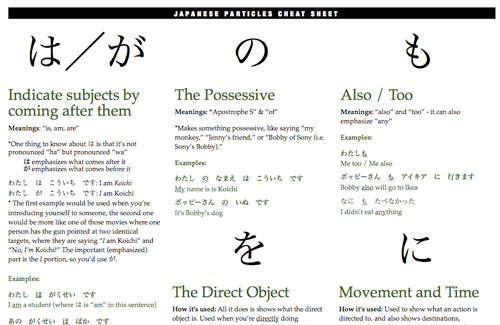

In this kind of sentence, the verb is purposefully missing, and the listener or reader is expected to complete the sentence in their head using world knowledge or context clues. These are the direct objects of the sentence! を at the End of a SentenceĪnother place you'll find を is at the very end of a sentence. In the second sentence, 梅酒 (plum wine) is the thing that Machiko makes. In the first one, ボール (ball) is the thing that is Kanae hits. In these sentences, particle を comes after the nouns that are affected by verbs. Particle を can appear after nouns to make them the object of the sentence. Patterns of Useįirst, let's talk structure - what kind of words or grammar structures can particle を attach to? Noun + を

Particle を has a lot of similarities with objects in English, but it also has some unique characteristics that make it a little different and challenging for learners. In other words it's what gets "verbed" in a sentence. Particle を marks the grammatical object of a sentence, which is the thing that is acted upon or affected by the verb. In other words, it marks the thing that gets affected by the verb. See you next time everyone またね.を tells us what the direct object of a sentence is. If it’s difficult, it means you are challenging yourself. Keep studying, pushing forward and never give up in the trying times.

If you have any more questions or ideas for content that you would like us to post in the future, please do not hesitate to get in touch as we love to hear your ideas. So, there we have it guys, we really hope that you have enjoyed today’s online Japanese lessons from Bondingo. We strongly suggest that you implement this technique as this is arguably the most important part of the lesson. It’s very easy to forge things that you are not using at all. Remember, if you don’t use it, you will lose it. The last thing that you need to do is create 5 – 10 examples of your own so you can become confident in using it. Once you have done this you will be able to understand and comprehend the patterns easily. Once you have those committed to memory try and translate the English sentences back to Japanese without looking at the translation. What you are going to need to do is look at the phrases that we have learnt today and ready them out loud to yourself 6 times each. So we’ve now come to the final process of the learning phase which is usage retention and confidence. An effective technique for master the Japanese particle “ka na” Now we are going to look at an effective technique that will help you remember the particle and allow you to use it yourself confidently.
#JAPANESE PARTICLES HOW TO#
We hope that has given you a little more insight into how to use the Japanese particle “ka na”. Last year didn’t treat you to well? Why not wonder to yourself if this year will bring something great. I wonder if this year will bring something good. Scared to check your bank account after a weekend shopping spree? Yeah, this would be the perfect time to use this phrase. This is a question I’m sure we can all relate to. Your friend is 10 minutes late and you start to wonder if you are in the wrong place? This is the perfect time to use this sentence. I wonder if I am waiting in the wrong place. Im sure we’ve all encountered this problem, oh the dilemma. In this example you are wondering what you should wear for a special occasion. Lets take a look at some examples sentences so you can understand the usage in various different scenarios. Is she going to show up? I wonder how much that is? I think it might rain? You are not directly asking the question to someone, you are simply wondering about question at hand.

You can use “ka na” when you are wondering about something. The verbs in the plain for can be used in all tenses too. Let’s look at the table below to see how this works. You should only use “ka na” after dictionary form verbs, nouns and adjectives. This sentence, meaning “I wonder how much it is” uses “ka na” at the end of the sentence to express “I wonder”. Take a look at this example below and we will break it down further. So “ka na” is a particle which means “I wonder” and is placed at the end of a sentence.


 0 kommentar(er)
0 kommentar(er)
